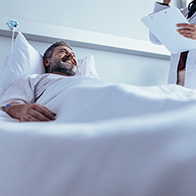Vasectomy Recovery: Tips, Timelines and Reversal Options

Vasectomy is one of the most common urological surgeries performed on men outside of diagnostic procedures. Fifty million men globally have undergone a vasectomy, according to Cleveland Clinic. Some estimates state that as many as 500,000 men in the United States undergo the procedure annually.
Vasectomy is safe, relatively inexpensive and permanent (though reversible). It can be performed on an outpatient basis using only local anesthesia.
We'll examine in detail some of the facts about vasectomy, including whether it might actually be reversible, what it's like to recover from a vasectomy and what, if any, protections vasectomy gives you against sexually transmitted infections (STIs).
How is a vasectomy procedure performed?
To understand what goes into vasectomy reversal, we should do a quick refresher on how a vasectomy procedure is performed.
A vasectomy involves the urologist giving the man a local anesthetic in his scrotum (not directly into the testicles). Once the area is numb, the urologist will create one or two tiny openings in the skin of the sac. From there, the doctor isolates the two vas deferens—the tubes responsible for carrying sperm from the testicle to be mixed with the rest of the man's semen when he ejaculates.
The vas deferens are then pulled to the opening in the skin and the doctor severs them, closing off each end with cauterization, clips or another method.
While the man's testes continue to produce testosterone and sperm, the sperm superhighway is closed, so to speak. The sperm cells can't join the rest of the semen when the man ejaculates, so the sperm cells can't exit the body and fertilize an egg.
Instead, they just mature and die.
What is recovery from a vasectomy like?
Recovering from a vasectomy is usually easy. Expect some mild pain and bruising. Some guys report feeling as though they've been kicked in the balls for a couple of days. Most patients are fine using over-the-counter NSAIDs such as ibuprofen. Urologists will frequently recommend that patients use an ice pack for the first few days as needed.
Having said that, different people have different tolerances for pain. For some guys, recovery is a breeze, a sensation they barely feel. Other men need to lie in bed and remain still for several days.
"Recovery is a little bit different for everyone," said Amy Pearlman, M.D., a men's health specialist and co-founder of Prime Institute in Fort Lauderdale, Florida. "I never want to tell someone that it'll be a super easy recovery, no issues, no pain. It typically involves a few days of rest, application of ice to the area, and no lifting or strenuous activity.
"March Madness is a really popular time. They can say to their partners they need to lay low and recover, so they're just going to watch basketball."
The latest method of performing a vasectomy—something called a no-scalpel vasectomy—means guys frequently are sent home without stitches. The opening the doctor makes is often so tiny that sutures are not necessary. Some urologists may still prefer to put in a stitch or two.
Either way, you'll want to pay attention to the place where the doctor made the opening in your scrotum to make sure it doesn't get infected. A bit of fluid draining out is to be expected and indicates your body is healing. Gently washing the wound daily and changing any gauze or dressing if it becomes stained or soiled is a good idea.
You'll need to wait about a week before attempting anything strenuous or lifting anything heavy. Also, abstain from ejaculating for about a week to allow the sealed-off ends of the vas deferens time to heal. That's an express line you've just shut down; you don't want to send sperm blasting through the freshly closed-off tubes before they're fully healed.
Speaking of making sure the surgery took, having a vasectomy doesn't render you immediately sterile. You need to undergo a follow-up semen analysis in six to 12 weeks. Even then it's not a 100 percent guarantee sperm isn't lurking.
"Another form of contraception is required until vas occlusion is confirmed," Pearlman said. "We confirm that with a post-vasectomy semen analysis (PVSA). But even if that PVSA shows that there's no sperm in the ejaculate, vasectomy is still not 100 percent reliable for preventing pregnancy. It can actually happen in 1 in 2,000 men who have no sperm in the ejaculate after vasectomy. Sometimes these vas ends find their way back to one another."
Does a vasectomy protect against STDs/STIs?
Vasectomy is birth control—nothing more, nothing less.
Vasectomy is a method to block a man's fertility. It doesn't affect testosterone, the ability to get an erection or the ability to ejaculate—nor does it offer any protection against STIs. If you plan to have sex with a new partner after a vasectomy, you should still wear a condom or use another form of protection.
Can a vasectomy be reversed?
Yes, vasectomy is considered a permanent form of birth control. It's never as easy to put Humpty Dumpty back together as it was to shove him off that wall. A vasectomy reversal procedure exists, but it's vastly more complex.
The success of a reversal depends on several factors, according to Pearlman, including:
- Time since the vasectomy
- The technique used for the original vasectomy
- The presence of scar tissue
"Success rates are generally higher if the reversal is performed within 10 years of the vasectomy," she said. "And a vasectomy reversal is typically not covered by insurance."
While the original vasectomy is a simple, in-office procedure, vasectomy reversal is much more involved. Plus, it has a success rate of just 60 percent to 95 percent, and pregnancy is only possible barely more than 50 percent of the time after a reversal, according to Cleveland Clinic.
"The procedure takes a couple of hours," Pearlman said. "Some urologists and fertility specialists will do it under local anesthesia, but the majority do it in the [operating room]. We use very thin sutures, about as small as a hair. You have to use an operating microscope to really see what you're doing; you can't even see it with the naked eye."
Conclusions
Vasectomy remains one of the most popular urological procedures for men. And for good reasons, including low cost, reliability, ease, relatively little pain and short recovery time. Most guys are up and about after spending a couple of days on the couch with ibuprofen and an ice pack. And they're back to 100 percent of activities within about a week.
As far as reversal goes, vasectomy is considered a permanent form of birth control. Reversing it may be possible, but it's not guaranteed to work. Vasectomy reversal is also expensive, usually requires full sedation and going into the OR, and insurance usually won't cover it.
If you're thinking about vasectomy, be certain before you get the procedure, and you can make your life, and that of your partner's, much easier.




















